Empress Theodora › Empress Irene » Ancient origins
Articles and Definitions › Contents
- Empress Theodora › Who Was
- Empress Irene › Who Was
Ancient civilizations › Historical and archaeological sites
Empress Theodora › Who Was
Definition and Origins
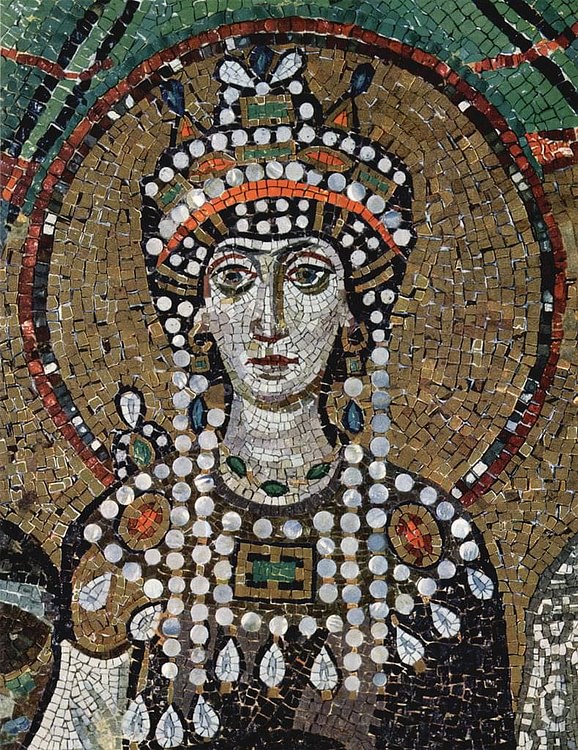
Theodora reigned as empress of the Byzantine Empire alongside her husband, Emperor Justinian I, from 527 CE until her death in 548 CE. Rising from a humble background and overcoming the prejudices of her somewhat disreputable early career as an actress, Theodora would marry Justinian (r. 527-565 CE) in 525 CE and they would rule together in a golden period of Byzantine history. Portrayed by contemporary writers as scheming, unprincipled, and immoral, the Empress, nevertheless, was also seen as a valuable support to the Emperor, and her direct involvement in state affairs made her one of the most powerful women ever seen in Byzantium.
EARLY LIFE
Theodora was born in c. 497 CE, the daughter of a bear-keeper called Akakios who worked for the Hippodrome of Constantinople. The 6th-century CE Byzantine historian Procopius of Caesarea states in his Secret History ( Anekdota ) that Theodora earned her living, like her mother before her, as an actress, which meant performing in the Hippodrome as an acrobat, dancer, and stripper. Theodora was said to have had one particularly lurid routine involving geese. By implication, considering the common association of the two professions at the time, she was also a courtesan. Procopius would have us believe an especially popular and lustful one, at that.
Procopius' Secret History, is, though, regarded by many as an outrageous gossip piece with a few facts thrown in for authenticity. The writer's attitude to both Justinian and Theodora is plainly that they were the worst thing ever to happen to the Byzantine Empire (in contrast to the official works he wrote under Justinian's patronage which are suitably laudatory of the emperor's achievements in war and architecture especially). Procopius also had it in for Antonina, the wife of Belisarius(Justinian's most talented general), and she is portrayed as constantly scheming with Theodora to create damaging palace intrigues. It is perhaps important to consider, too, that our knowledge of Theodora only comes from male authors and a woman performing any other role than the traditionally submissive one in Byzantine society was bound to be, at best, disapproved of and, at worst, outright demonised.
WITH THEIR LAVISH CORONATION IN THE HAGIA SOPHIA, JUSTINIAN & THEODORA SEEMED TO HERALD A NEW ERA FOR THE BYZANTINE EMPIRE & ITS PEOPLE.
Before she married Justinian, the nephew of Emperor Justin (r. 518-527 CE), in 525 CE, Theodora left the sands of the Hippodrome to travel to North Africa as the mistress of a medium-level civil servant. After the relationship broke up, she made her way back home via Alexandria where she may have converted to Christianity.
The marriage between such a lowly figure as Theodora and a future emperor was an odd rags-to-riches one, but there was a tradition in the Byzantine court for emperors to marry the winners of beauty contests organised for that purpose. The entrants to such contests could come from lower classes and from far away provinces so such mismatches were not unheard of. The lowly status of Theodora was not ignored by everyone, and one particularly passionate opponent was Empress Lupicina Euphemia, indeed, her death seems to have removed the foremost obstacle to the marriage. Justin I even went so far as to amend the laws (senators, which Justinian was, could not marry actresses) in order to permit the marriage and to legitimise Theodora's illegitimate daughter. Procopius also claims there was an illegitimate son, too, but no other sources substantiate this.
The Empress, 20 years younger than her husband, is described by Procopius as being short but attractive, a stickler for court ceremony, and a lover of luxury. Theodora was crowned as empress in the same coronation ceremony as her husband on 1 April 527 CE. Justinian had insisted his wife be crowned as his equal and not as his consort. The pair also matched each other in intelligence, ambition, and energy, and with their lavish coronation in the Hagia Sophia, they seemed to herald a new era for the Byzantine Empire and its people.
THE NIKA REVOLT
Theodora's active role in Byzantine politics and the staunch support she gave her husband are best revealed by the incident of the Nika Revolt of 11-19 January 532 CE. This was an infamous riot caused by factions of the supporters in the Hippodrome of Constantinople. The real causes for complaint were Justinian's tax hikes (to pay for his incessant military campaigns) and his general autocracy, but the riot was sparked by the emperor's refusal to pardon Blue and Green supporters for a recent outburst of violence in the Hippodrome.The troublemakers joined forces for once, and using the ominous chant “ Conquer !” ( Nika ), which they usually screamed at the particular charioteer they were supporting in a race, they organised themselves into an effective force.
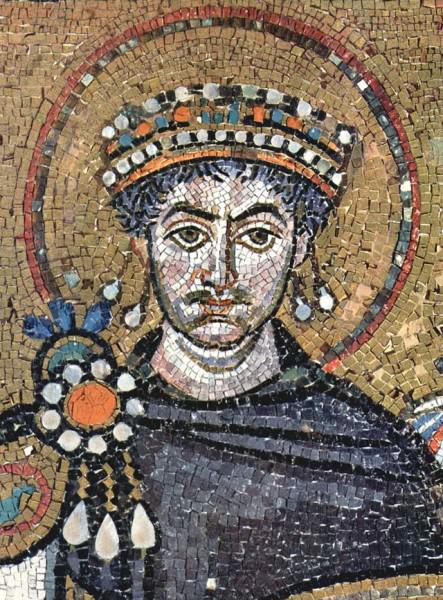
Justinian I
The trouble began with Justinian's appearance in the Hippodrome on the occasion of the opening races of the games. The crowd turned on their emperor, the races were abandoned and the rioters spilt out of the Hippodrome to rampage through the city. They left an impressive trail of destruction wherever they marched, burning down the Church of Hagia Sophia, the Church of Saint Irene, the baths of Zeuxippus, the Chalke gate, and a good portion of the Augustaion forum including, significantly, the Senate House. The starting point of all this destruction, the Hippodrome, escaped with only minor damage.The riot had become a full-scale rebellion and Hypatios, the general and nephew of Anastasius I (r. 491-518 CE), was crowned in the Hippodrome as the new emperor by the rioters.
Justinian was not to be so easily pushed from his throne, although it is Theodora who is credited with persuading the Emperor not to flee the mob but stand firm and fight. Her words at that crucial moment were recorded by Procopius as follows:
I do not care whether or not it is proper for a woman to give brave counsel to frightened men; but in moments of extreme danger, conscience is the only guide. Every man who is born into the light of day must sooner or later die; and how can an Emperor ever allow himself to become a fugitive? If you, my Lord, wish to save your skin, you will have no difficulty in doing so. We are rich, there is the sea, there too are our ships. But consider first whether, when you reach safety, you will not regret that you did not choose death in preference. As for me, I stand by the ancient saying: royalty makes the best shroud. (quoted in Brownworth, 79-80)
The imperial cause was greatly helped by the gifted generals Belisarius and Mundus, who ruthlessly quashed the revolt by slaughtering 30,000 of the perpetrators inside the Hippodrome. Hypatios, who had not actually wished to be crowned by the rioters, was executed nonetheless. No games were held in the Hippodrome for several years after the crisis, but one happy consequence of the whole destructive episode was the required rebuilding programme which resulted in the construction of the present version of the Hagia Sophia church.
ATTITUDE TO THE CHURCH
Theodora's religious policies seem to have been entirely her own, they were certainly not those of her husband, the leader of the Byzantine church and protector of orthodoxy. The Empress favoured Monophysitism, that is the belief that Jesus Christhad only one, divine nature ( physis ), which went against the orthodox view that he had two natures - one human and one divine. Nor were her views merely theoretical ponderings, for Theodora acted upon them and protected and housed priests and monks who adhered to monophysite beliefs, even using the Great Palace of Constantinople to do so. Indeed, the Empress is credited with the promotion of, and ultimately achieving the adoption of, Monophysitism in Nubia around 540 CE.
BESIDES THE DARKER TALES OF PERSONAL VENDETTAS & CRONYISM, THEODORA WAS NOTED FOR HER INFLUENCE ON JUSTINIAN'S SOCIAL REFORMS & HER CHARITABLE WORK.
POLITICAL INTRIGUES
Theodora's political manoeuvres are blamed for the downfall of the chief minister John of Cappadocia, although he was none too popular with the Byzantine people either because he was seen as the instigator of the oppressive tax reforms which had caused the Nika Revolt. Procopius, too, paints the finance minister as a paradigm of corruption and debauchery. John was dismissed after the revolt as one of the demands of the rioters but he later made a political comeback. It was then that Theodora was said to have conspired against him out of personal hatred. John was thus banished from court in 541 CE.
Other victims of the Empress' machinations were Pope Silverius (deposed in 537 CE) and possibly the Gothic queen Amalasuntha, who was assassinated, but real details and hard evidence are lacking. Belisarius was another who found himself in Theodora's bad books. He might have been a great general, perhaps Byzantium's greatest, but his success only aroused the suspicions of the empress, who may well have coloured her husband's dealings with his foremost commander, which resulted in a lack of material support in the field of battle when needed.
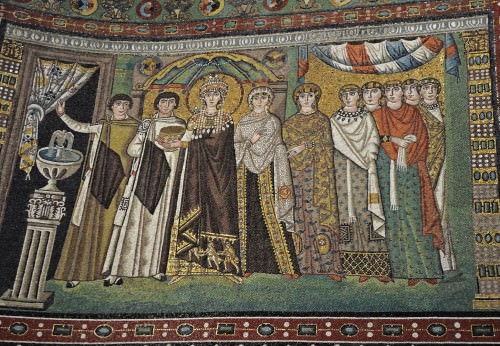
Empress Theodora & Her Court
Worse was to follow for Belisarius when the devastating bubonic plague struck the empire in the spring of 542 CE. Justinian himself was infected; he survived, but while he was gravely ill, Theodora ruled alone. Seeing that if her husband died, and with no heir to play regent for, her position would be untenable, the Empress moved quickly against the general she regarded as her greatest rival for the throne. Belisarius was too popular a figure to simply imprison or murder but he could be cut down a peg or two, and so Theodora ordered he be relieved of his command and his property be confiscated. Fortunately for the general, when Justinian recovered the following year and with the Moors and Goths baying at the frontiers of the empire, he was restored to his former position.
DEATH
Theodora died in 548 CE, aged just 51 or 52, probably of cancer. Justinian had no heir but, perhaps significantly, he never remarried. Theodora's daughter from before her marriage to Justinian had three sons and all of these became prominent figures in the Byzantine court. Justinian, after a period a deep mourning, would rule for another 17 years but he never seemed quite so focused or as brilliant as when he had had Theodora by his side.
Procopius might have stolen the accolades for most-lasting and colourful literary portrait of the Empress but, in the visual arts, there is a formidable rival to how Theodora is remembered in history. This most celebrated of depictions is in the church of San Vitale in Ravenna, Italy. The glittering wall mosaic shows the Empress in one panel while another shows Justinian and the archbishop of Ravenna, Maximian (r. 546-556 CE). Theodora, like her husband, is portrayed with a large halo. She is also wearing a great deal of jewellery with necklaces, earrings, and a fabulous gem-studded crown, and a Tyrian purple robe. She presents to the church a jewelled gold chalice and is surrounded by officials and her extensive entourage of court ladies.
Empress Irene › Who Was
Definition and Origins
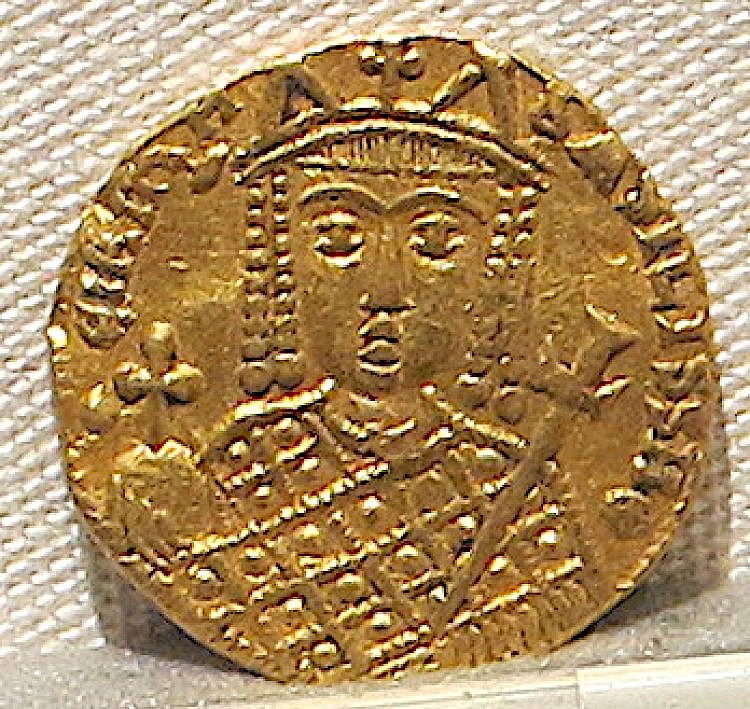
Empress Irene was the wife of Leo IV and, on her husband's death, she reigned as regent for her son Constantine VI from 780 to 790 CE. From 797 to 802 CE she ruled as emperor in her own right, the first woman to do so in Byzantine history.During her lacklustre reign, Irene ruthlessly schemed and plotted to keep the throne she would lose and regain three times, but she is chiefly remembered for restoring the Christian veneration of icons, which her predecessors of the Isaurian dynasty had sought so vehemently to repress. Even this seemingly pious campaign was really only a means for Irene to defeat her enemies and keep power. The Empress' gold coins reveal much of her duplicitous character for, uniquely, they carried a portrait of herself on both sides.
EARLY LIFE
Little is known of the young Irene except that she was an extraordinarily beautiful orphan girl from Athens, born c. 752 CE.Emperor Constantine V (r. 741-775 CE), holding an empire -wide beauty contest for the purpose, fished her from the obscurity of the provincial town that Athens had then become and arranged for her to marry his son, the future emperor Leo IV, who would reign from 775 to 780 CE. The wedding took place in 769 CE, and she immediately influenced state policy by tempering her husband's attacks on the Church's veneration of icons. Leo's short reign came to an end when he died of fever, aged 30, while campaigning against the Bulgars, but Irene's appetite for power needed further feeding.
IRENE AS REGENT
Constantine VI ruled from 780 to 797 CE, inheriting his title aged just nine. Ruling as regent for her young son over the next decade, Irene quashed a rebellion led by the sons of Constantine V, dismissed ministers and military men whose loyalty was questionable and made use of the experience of two court eunuchs, in particular, Staurakios and Aetios. The former was logothetes tou dromou or chief minister with a wide range of powers. In 783 CE Staurakios sent a Byzantine army to fight the Slavs in Greece, and the next year Irene enjoyed the first military successes of her reign against both Slav and Arab armies.
IRENE & 350 BISHOPS FINALLY RULED TO RESTORE THE ORTHODOXY OF THE VENERATION OF ICONS IN THE CHRISTIAN CHURCH.
Religious affairs seem always to have been foremost in the regent's plans, and in 784 CE she made her former secretary Tarasios the Patriarch (Bishop) of Constantinople, despite him not yet being ordained. Next, Irene convened a Church council in Constantinople in 786 CE to put an official end to the destruction of icons (iconoclasm). However, influential members of the army were against such a move, and they organised a riot which forced the closure of the council meetings.The Empress was not to be deterred, though, and she swiftly stationed the troublemakers to Asia Minor under the guise of preparations for a new military campaign. Once abroad the army was disbanded and their positions of authority back home taken by those more loyal to the Empress.
With the army opposition dealt with, Staurakios accompanied Irene to the Seventh Ecumenical Council at Nicaea in September 787 CE. There Irene and 350 invited bishops finally ruled to restore the orthodoxy of the veneration of icons in the Christian Church and end iconoclasm. The persecution of iconophiles had been a key feature of previous emperors' reigns, especially Irene's father-in-law Constantine V, so the Empress could not be too harsh on the perpetrators and risk alienating family members at court. Instead, they were permitted to repent of their sins and welcomed back into the Church now glittering once again with its precious icons.
EXILE FROM COURT
When Irene made it be known that she intended to rule above her son Constantine no matter how old he was, many of those who opposed the restoration of icons, saw the dangers to the empire's army strength Irene's purges had threatened, and who believed Constantine had the rightful claim to the throne alone, rallied around the young emperor. Irene responded by throwing him in prison, but by 790 CE the army came to Constantine's support and released him. The army still contained many iconoclasts, and they had refused to swear loyalty to Irene alone on religious grounds. Now 19 years of age and keen to remove his interfering mother once and for all from state affairs, Constantine banished her from court along with her closest advisors while he engaged Michael Lachanodrakon, the influential general and governor of the Thrakesion region of the empire. After a decade in the shadows, Constantine took his rightful place at the apex of Byzantine government.
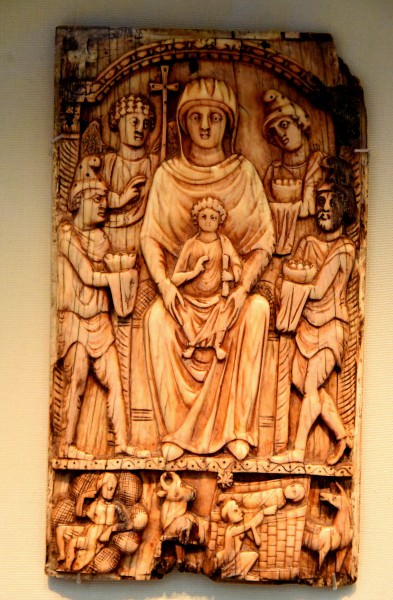
Byzantine Ivory Panel Depicting the Adoration of the Magi
Unfortunately, the young emperor was not actually up to the task. Serious and immediate defeats against the Bulgars and a shameful truce against the Arabs did nothing to aid his popularity, and conspiracies at court were rife. One led by Constantine's uncle Nikephoros was quashed, and the emperor blinded the ringleader in an all too familiar act of imperial Byzantine brutality. Constantine then ordered the tongues of all four of his uncles to be torn out. It was a rare moment of decision, but it was too little, too late.
Irene was not to be so easily ushered to the wings of power, either, and she returned to the court in 792 CE, invited by her son as a last-ditch attempt to restore some order to his reign. In effect, they ruled jointly for the next five years, but Irene soon began to plot against her son. Significantly, Constantine could no longer call on the support of Michael Lachanodrakon, the general having been killed that year while campaigning against the Bulgars. The army was all too unimpressed with the young emperor, and his popularity plummeted even further when he began to blame his soldiers for their defeats, taking the ill-advised action (cunningly suggested by Irene, of course) of tattooing the word “traitor” on the faces of 1,000 of them.
IN 797 CE IRENE TOOK BACK THE THRONE FOR HERSELF & BLINDED HER SON, DOING SO IN THE SAME PURPLE CHAMBER OF THE PALACE IN WHICH HE HAD BEEN BORN.
A final crushing blow to Constantine's ambitions was the protests following his divorce and subsequent marriage to his mistress Theodote, the so-called Moechian Controversy, in 795 CE. To make matters worse, the couple had a son 18 months later. Two monks were especially vociferous in their outrage at the emperor's behaviour as head of the Church, Plato of Sakkoudion and Theodore of Stoudios, who both claimed that his divorce was illegal and so in marrying again the emperor had committed adultery. The emperor had lost the support of the one group he could always depend on; the iconophiles.Constantine's unpopularity with his people and the Byzantine establishment meant that he had no friends left to block his removal from power by his own mother.
RETURN AS EMPRESS
In 797 CE, when Irene took back the throne for herself, she blinded her son, doing so in the same purple chamber of the palace in which he had been born. There was not going to be another rebellion against her rule. Constantine died shortly afterwards, almost certainly as a result of his injuries, which were intended to kill not maim. With his heir having already died earlier the same year, Irene now had dealt with all her challengers. Thereafter, Irene is referred to in official state records as basileus, emperor, and not as empress, the first woman to so rule in her own right.
She continued to take an interest in all matters of her empire: politics, warfare, and religion combined and tried to win favour by announcing reductions in taxes for her people. She was not without her troubles, though, as rebellion was still in the air and was given focus by the surviving, albeit maimed, sons of Constantine V. The Arabs had to be paid off to avoid further invasion, all but bankrupting the state, and the people could never quite forgive her for her crimes, even if she did provide soup kitchens for the poor and accommodation for the elderly. Riding around Constantinople in a golden chariot launching coins into the crowds did not help much either. Troubled times were in store for Byzantium ’s most ambitious and ruthless of sovereigns.
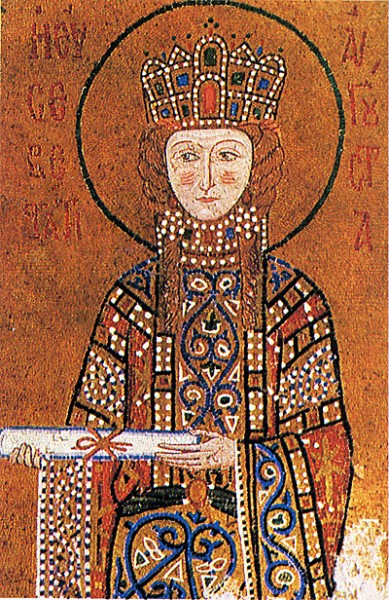
Byzantine Empress Irene
In early 802 CE, Irene attempted a marriage of alliance with the Franks ' king Charlemagne, who was also the newly declared Emperor of the Romans in the west, and who, likewise, was in favour of once more unifying the two halves of the old Roman empire. A similar plan had already been attempted when Irene had arranged for her late son to marry Rotrud, the daughter of Charlemagne, but Irene had broken off the engagement in 787 CE. However, the new approach to join the two families met fierce opposition, especially from the powerful eunuch Aetios in Constantinople. It simply would not do for a Byzantine emperor to marry an illiterate barbarian, even if he had been blessed by the Pope and wore spectacular red tights.
In October 802 CE the highest court officials in Constantinople convened in the Hippodrome and declared the Empress surplus to requirements. Irene was removed, exiled to a monastery on Lesbos and succeeded by Nikephoros I, one of the Empress' former finance ministers. Irene died within a year of losing the throne she had loved so much and clung onto for so long. The historian JJ Norwich gives this grim assessment of Irene's reign:
Scheming and duplicitous, consumed by ambition and ever thirsty for power, she brought dissension and disaster to the Empire, being additionally guilty of one of the foulest murders that even Byzantine history records.(115)
Nikephoros would reign until his death in battle in 811 CE, unable to halt the decline of the Byzantine empire as Charlemagne's own empire rose in the west and the Muslim Abbasids threatened from the east. The cycle of royal assassinations that Irene began with the murder of her son would keep on turning so that the Byzantines would see six emperors in the space of 15 years.
LICENSE:
Article based on information obtained from these sources:with permission from the Website Ancient History Encyclopedia
Content is available under License Creative Commons: Attribution-NonCommercial-ShareAlike 3.0 Unported. CC-BY-NC-SA License